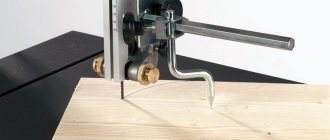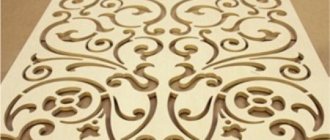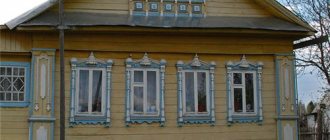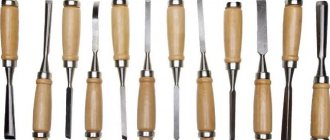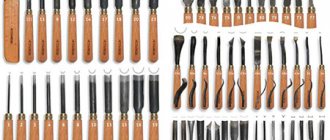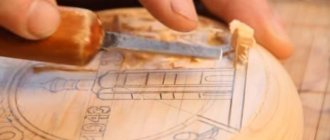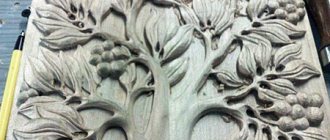Hello my dear friend. Today we will talk about such an ancient hobby as wood carving. I promise it will be interesting, and perhaps you will also want to try your hand at this craft.
“All types of art serve the greatest of arts - the art of living on earth.”
Bertolt Brecht
Wood carving: history of appearance
Wood carving is a type of decorative and applied art, a folk artistic craft.
Artistic processing of wood has been known since ancient times. Almost all peoples of the world have their own national cutting methods. As tools improve, wood cutting technologies also change. Being one of the main folk crafts, modern artistic carving has borrowed many techniques from national traditions.
In Ancient Rus', wood was widely used for a variety of purposes: from construction to making dishes. However, due to its natural properties, only a small part of the products has survived to this day.
Studying ancient chronicles, we can conclude that the first carved patterns appeared among the Old Slavs: carpenters and joiners.
If we think logically, it’s quite difficult to agree with this - after all, cave paintings are considered the very first painting. If primitive people knew how to draw with stone cutters on wood or stone, it would be strange to assume that creating a more complex ornament or carving a drinking cup would have been a problem for them.
Most likely, precisely because of the poor preservation of wooden utensils in natural conditions: soil and dampness, we cannot find out the exact date of the appearance of this craft.
A striking example of Slavic artistic carving are wooden houses - architectural monuments of the 18th-19th centuries, which have become a national treasure and a characteristic feature of Russia.
The peasants paid great attention to decorating their houses: high pediments with carved animal heads, floral and geometric patterns were preserved not only in books.
We can observe archaic geometric patterns in the decoration of houses in the Kostroma and Arkhangelsk provinces. The platbands, roofing and windows are decorated with carvings.
In the outback you can find a real treasure trove - old houses, some of which are still looked after by their heirs. In the Volga region, from the beginning of the 18th century, baroque carvings, borrowed by house architects from shipbuilders, were widespread. Houses were decorated in a marine style: mermaids, fish, and plants were carved on the porches, gates and facades.
Along with decorating residential buildings, handicrafts developed in Rus' - craftsmen carved utensils, household items (spinning wheels, sleighs), wooden toys (matryoshka dolls, horses and other figurines) from wood. Most of the items were hand-painted, which contributed to the development of folk crafts - such goods were sold out at fairs.
In the mid-19th century, a new type of design appeared in the Volga region and Siberia - sawn (openwork) carving, which became a kind of calling card of Russia. The ornaments of openwork carving partially copy the technique of making relief patterns, except that the sawn carving does not provide a background.
Flat-relief and relief carving
Flat relief carving is also very common. Its distinctive feature is the ornament of the same height. Often compositions are created with a simple design: geometric shapes, plant leaves, images of animals and birds.
Wood carving of this type will require perseverance, rich imagination and a variety of tools from the master: knives, chisels, chasers, scrapers, rasps, etc.
This type of carving is distinguished by subtypes:
- pillow background;
- selected background;
- oval outline.
In relief carving, the design stands out noticeably against the general background. In this form there are practically no flat surfaces. The pattern contains dots of varying heights and shapes. Relief carvings decorate furniture, walls, and make elegant panels.
Relief wood carving is divided into two subtypes: bas-relief and high relief. For carving, choose hard wood: oak, beech, cedar, fir.
Advantages of artistic cutting
Today, openwork carving is being revived in modern houses of our country, as, in principle, carving in general. After all, what gives warmth cannot remain in oblivion for long.
- Wood carving as a hobby gives you the joy of doing what you love. If you can translate it into income, even better.
- Wood carving is calming. In all the bustle, we so often lack silence and the opportunity to be alone for at least a few minutes, left alone with ourselves.
- Carving, as a calm, monotonous work, improves the functioning of the brain, clearing it of fears and phobias, and gives a person healthy pride in the result obtained.
“Success is the ability to wake up in the morning and fall asleep in the evening, having time to do what you really like in between these two events.”
Bob Dylan
Type of thread
Modern wood carving is divided into the following categories:
Volumetric (sculptural)
The image is completely or partially separated from the background. The technique is similar to bas-relief.
Flat-relief
The image is emphasized against the background by deepening the background.
Welted (openwork)
Refers to the through stitch technique. The background in the products has been completely removed. Previously, they were often used to decorate icons and paintings as frames.
Contour
It is considered one of the simplest techniques. Often used by beginners for practical training. Contour carving is a pattern created by the intersection of shallow lines. When compared with sculptural art, the closest analogue of this technique is ankre or koylanaglyph.
Geometric
Like contouring, it is a simple technique that can be used even by beginners. The pattern is formed from various geometric shapes and their interlacing. Despite the apparent simplicity, the works are transformed under the play of light and look very beautiful.
Embossed
There is practically no flatness in the product. Each structural element protrudes from the surface to a different height. There are two subtypes of relief: high relief and low relief. In the first case, the image occupies almost half the volume, and in the second - only a few centimeters.
Eastern
Characterized by a wealth of subtle patterns achieved by the intersection of straight and curved lines. Flowers often appear in patterns as additions.
The above techniques are considered basic, but the list is not limited to them. Sculptural techniques with embossed and cushion backgrounds and block sculpture are much less common. Among the wide variety of carving types, a master of any level will find a direction to his liking.
Types, features, examples
Wood carving is a decorative method of processing wood for the purpose of its artistic design: in the form of shapes, patterns, reliefs. Quite painstaking work, which was previously performed exclusively manually, is now being automated with the help of electrically driven copy-milling devices.
The use of automated cutting greatly simplifies work, and is justified in carpentry and furniture workshops - where items are produced in large quantities for the purpose of sale. But still, the value of wood carving lies precisely in its uniqueness, exclusivity, of each copy - that is, directly in manual production.
Artistic processing will favorably emphasize the style and sophistication of the interior, creating a special atmosphere of comfort and respectability. People who have the means to purchase designer products tend to move away from conveyor belt purchases: pieces of furniture, dishes, decor - in such houses they always attract the eye and capture the imagination.
Carved patterns with whimsical shapes add a touch of elegance to any interior.
Geometric carving
This type of wood carving is the simplest and most accessible to many craftsmen. Geometric threads are special wedge-cutting grooves of different directions and depths. The number of edges in each individual recess can also be different. But the most common ones are with two and three notches.
Triangular carving gives the greatest number of possible patterns. Fewer compositions can be created using tetrahedral carving, and it requires special skill from the carver.
Geometric threads also include staple threads. The design in it is made with a semicircular chisel, first at a right angle, and then at a sharp angle. For geometric wood carvings, linden, aspen, and coniferous wood is used.
Types of wood carving
Each technique developed separately: craftsmen carved household and interior items, sharpened utensils to their own taste and in their own way.
Decorative wood carving has 6 main cutting techniques and their subtypes. Let's look at beauty in detail.
Flat grooved - carving made on a flat background with recessed patterns of various shapes and recesses. The ornament over the entire surface of the background is flat with the same height.
Usually flat carving is used for souvenir products. Patterns in a 5-7 mm recess can be concave, straight or convex.
Divided into:
- Contour, the background of which is a varnished surface. The pattern is made using a corner chisel, a jamb knife, a narrow (semicircular) chisel or a cerasis.
- Staple (nail-like) carving made with chisels of different diameters. As a result of the master’s work, flat semicircular depressions appear.
- Geometric (wedge-shaped, triangular), love for which appeared among beginning craftsmen because of the ease of execution. The patterns are cut using one single tool - a blunt knife.
Sculptural - volumetric carving, which received its original purpose in churches. Altars were decorated with it, crosses and images were carved out. Pieces of furniture made in classical and palace styles are often decorated with sculptural carvings.
This technique is widely used not only in carving large items and sculptures, but also in children's toys - items that require detailed processing of the shape.
Flat-relief – a thread with a low level of relief located in one plane. This type of decoration can often be seen in the interior decoration of wooden houses.
Divided into:
- With an oval contour - performed using a chisel at a slight angle of inclination and with the same depth of cut. After cutting, the sharp edges are rounded (ovalized).
- With a cushion background - carvings with convex shapes on all surfaces of the product, reminiscent of cushions. The edges of the pattern are steeply rolled, the background is at a slight angle.
- With a selected background - a complex type of carving in which several tools are used: cranberries, chisels. By analogy with an oval carving, an incision is made, trimming is performed along the intended contour, and the background is selected using cranberries, straight chisels of different depths and widths, depending on the design.
Brownie is one of the oldest techniques in home decoration, combining the basic elements of blind and openwork carvings. Blind carvings had no through elements and protected the wood from rotting.
It was used mainly to decorate doors and shutters, railings, pediments, and the facade of the house. The transom was decorated with openwork carvings or overhead inserts were attached above the entrance.
Relief - the relief in this type of carving is made at different heights, and the background is always blank.
It differs from other types in greater expressiveness, an abundance of complex elements that create volume and play of shadows in the composition. To perform relief carving, you need several tools: jamb knives, semicircular chisels of various widths, and cranberries.
Divided into:
- Bas-relief - patterns with a slight elevation above the background. It is found on gates, friezes of houses, boards, frames, and trims.
- High relief - a high pattern with convex shapes, significantly rising above the background. Such carvings are used for monuments, paintings, icons, in houses - pilasters, columns - where the design is clearly visible both from the center and from the side.
Sawed (slotted, openwork) – a carving with a removed background. The combination of relief or geometric carving creates the impression of lightness and airiness of the product.
Through patterns made with a special saw are used to decorate wooden houses (cornices, platbands, piers).
Each cutting technique directly depends on the tool used. It's time to take a closer look at it.
House carving
The main characteristic of home wood carving is its large scale. It is performed using the simplest tools: an ax, a chisel and a saw. Coniferous wood is used.
Wood carving for home decoration was well developed more than five centuries ago. In the north of Russia, the most ancient wooden buildings decorated with carvings have been preserved. There are many wooden carved houses in the Volga region.
Many researchers believe that the art of decorating residential buildings with carvings came from shipbuilding. Often house and ship carvings mean the same thing. House carvings are divided into volumetric, relief and slotted.
Probably the first three-dimensional carvings were on the bows of ships. They included figures of a bird, a horse, and a deer. Relief carvings decorate the gables of houses, windows, and trim. The slotted look appeared in the 19th century. Openwork decorations were cut out with a jigsaw and decorated houses, railings, and entrances to premises.
Tools and materials for wood carving
Whatever technique we choose: drilling, sawing, gouging, we cannot do without tools. It is possible to obtain the most valuable, single specimens only with the help of hand carving. Therefore, we will consider exclusively hand tools.
Basic and auxiliary tools that every carver will need:
- Drawing (to create a sketch of a pattern and transfer it to a wooden base): pencils, tracing paper, paper, carbon paper, ruler, compass.
- Cutting tools (we will use them to make the ornament): chisels, spoon cutters, knives, cranberries.
- Fastening (for convenient fixation of the workpiece during work): vice, clamps.
- Materials for grinding : sanding machine - for processing large elements of the exhibition (furniture, sculptures with a flat background), sandpaper - for manual grinding of small parts, complex patterns, volumetric areas.
- Wood glue – for gluing individual elements.
- Coating (to give the product a finished look and to protect the wood): varnish, paint, stain, wax, etc.
Beginning carvers should purchase simple hand-cutting kits or even individual tools (they can be purchased individually). For comparison: the cost of a professional set starts from 20 thousand rubles, a basic one – from 1.5 thousand rubles, and the price of one knife is about 300 rubles. Here is our helper plate, you can safely rely on it when choosing a tool.
Blunt knives
Used for small recesses. The width of the blade is from 4 to 50 mm, and the bevel angle is 35°. According to the type of sharpening there are: single-bevel, double-bevel
Knives with short blades (flags) can be used to cut using either a forward or backward technique.
Knives
The knife is used in geometric, contour and sculpture cutting of soft and medium density wood.
The best material when choosing cutters is hardened steel.
Chisels
They come in different shapes: straight, sloping, angular, semicircular. They are used to create both shallow reliefs and semicircular recesses, as well as for making grooves and cleaning cavities in wood.
Angled chisels are used to create patterns of shallow depth (grooves).
Spoon knives (spoon cutters, cranberries)
Spoon cutters can combine both the features and appearance of cranberry and a knife.
They perform volumetric cutting - internal spherical surfaces in the manufacture of spoons, bowls, and scoops.
Staples (scrapers)
To remove the first rough (untreated) layer of wood
All staples vary in size, angle of inclination and width of the cutting blade. Depending on the area to be processed, choose the width of the staple blade
Mints
A hand tool in the form of an octagon or a round metal rod with a different blade shape (rounded, chisel-shaped or cone-shaped).
Metal rods are used to cut out a textured geometric pattern
The thickness of the blade of the selected knife should be no more than 4 mm, and the length should not be more than 5 cm. Do not try to purchase knives with a long working blade, they are not very convenient to work with.
There are knives made from low carbon steel on sale. The big problem is that they become dull faster and can break when working with high-density wood. The best knives for wood carving are those whose working blade is made of high-carbon steel and is marked 55 - 60 RC. The presence of replaceable blades will eliminate the need for periodic sharpening.
If you purchased a knife with a fixed blade, then preventative care will help keep the tool in good condition.
Secret geometry
Spinning wheel leg. Vologda region, Tarnogsky district, Denisovskaya village. Master Stepan Ogloblin. 1890
Roller for beating clothes during washing. Zaonezhye. Late XIX - early XX century
Strand. Zaonezhye, Mezhvezhyegorsky district, Republic of Karelia
Geometric carving is the oldest design trend, known to mankind since pre-Christian times. Apart from a good eye and a confident hand, he did not demand anything from the master. Even a special tool: when applying the ornament, the carver could get by with an ordinary knife. As a rule, small objects were decorated with such carvings, which turned into a talisman. The fact is that the simplest patterns in the form of geometric shapes were symbols of elements and phenomena. By placing them in a certain order, the ancient masters tried to protect themselves from the forces of nature or, conversely, call on them for help. Such patterns were a kind of magic book for those who knew how to read them. A rosette with rays or just a circle called the grace of the Sun into the house. The cut diamonds were supposed to give the owner strength and power. A pattern of triangles applied to a primitive figurine of a horse was supposed to bring health to all livestock. Subsequently, rarely did any of the carvers use geometric carving according to pagan covenants - with the required number of spells and the number of swings of the knife. But objects decorated in this way can still be found in northern villages.
Instrument care
Periodically, you need to take care of the tool: check the knives for corrosion and sharpen them. You can use several methods for sharpening: whetstones, sandpaper or leather belts, choose the most suitable for yourself.
First, the blade is sharpened using a fine abrasive (diamond chips or sandpaper). Both sides are processed until burrs appear, then these irregularities are eliminated with a fine-grained abrasive, and the final stage is polishing the blade. The quality of sharpening is checked on a block of wood - if you run the knife across, the fibers should not fluff. A straight line indicates the required degree of sharpening.
Experts recommend using special belts. The tool consists of a metal ring and a handle. Used by professional sharpeners, the leather belt is great for finishing the blade.
The ideal condition of the cutting blade is achieved by sharpening the knife along a tensioned belt in the direction of movement. You need to press the canvas without unnecessary pressure at a slight angle. At first, the emphasis is made stronger, and towards the end of the belt it is weakened so that the cutting blade goes to the top.
Used in conjunction with a polishing belt, the pastes serve to finish the knife, giving the blade a smooth, high-gloss shine. The composition is applied directly to the belt.
On sale you can find many pastes containing various abrasives. Most of them are perfectly replaced by the well-known GOI paste. It is also available in varying degrees of grain size, and is suitable for both ductile metals and high-carbon steel, glass, ceramics and other materials.
Store tools in separate (preferably wooden) cabinets, pre-wrapped in cotton or canvas fabric.
Cleaning from traces of oxide
If the knife shows signs of corrosion, it is not time to throw it away. You can try to revive it.
- Pitting corrosion is removed using an eraser or auto polish with a fine abrasive fraction.
- Cavities are removed with scratch polish, and then also polished with a fine abrasive compound.
- Large areas of rust can be cleaned with sandpaper, then polished.
The use of polish at the final stage of processing is mandatory!
Home → History of folk crafts → Wood carving
The art of wood carving has been known since ancient times. It was carved elements that decorated village and city wooden houses in Rus'. At the same time, these elements were made using simple and accessible tools - an ax, a saw, a carpenter's chisel. Over time, tools for carvers were improved and modified. Machines appeared with the help of which it became possible to realize the most complex patterns in wood.
House carving as a living form of folk art exists in rural areas to this day, and the underlying geometric carving, formed on the traditions of carvers of spinning wheels, gingerbread boards, and various household utensils, is considered a Vyatka folk art craft. Complex volumetric carvings are found not only on elements of houses, but also on expensive Vyatka furniture and church iconostases in temples.
Geometric wood carving
Geometric carving is one of the most ancient types of wood carving.
It is made in the form of two-, three- or tetrahedral recesses, forming on the surface a pattern of geometric shapes - triangles, squares, circles.
Geometric carvings lavishly decorated huts, religious buildings (iconostases, icon cases), all kinds of furniture (tables, benches, cradles, chests, chests, hooks for washstands), turned and dugout dishes (various bowls, ladles, salt shakers, trays, spoons, jugs) and tools (spinning wheels, weaving mills, rollers, seamstresses, gingerbread boards).
Back in the 20s of the twentieth century, in the Vyatka bazaars one could buy products decorated with skillful carvings. For a long time, the ancient craft existed separately. By the end of the 1930s, handicraftsmen united into artels. In 1947, the Pobeda artel united 107 homeworkers, half of whom were engaged in artistic woodworking. Artel produces boxes of various configurations, pencil cases, towel holders, medicine cabinets, decorated with geometric carvings and paintings.
In 1954, the artel mastered the production of carved boxes with inlay. In 1955, the artel carried out a lot of experimental work - the use of several techniques in the manufacture of one product (carving, inlay, burning, painting), the image became more complex, and landscape and architectural subjects of monuments in Moscow, Leningrad and other cities were introduced. In 1958, craftsmen and artists from the Pobeda artel completed a large order for the World Exhibition in Brussels. This year, the company’s assortment includes 70 types of artistic products and this is the only industrial market in the country with such a product profile.
With the formation of the Department for the Production of Toys and Arts and Crafts in 1968, all activities in artistic woodworking were concentrated at the Ideal art products factory. Already in the 1970s, geometric carving became firmly established in the artistic design of the main product range of the Ideal factory.
From the simplest elements, master carvers learned to create rich patterns used to decorate not only boxes, but also various household items. Using traditional ornamental elements, craftsmen build the composition of the product on a circle, which is then carefully designed.
Clean carving, deep sampling of the background, large details of the ornament, necessarily enclosed in a frame of contour carving - these are the features of boxes from the Ideal factory.
To enrich the artistic image of the product, craftsmen use additional means to enhance the decorative effect of the product, using natural materials (straw, embossed birch bark) in the carved box.
Currently, the successor to the Ideal factory, the Ideal Plus enterprise, is engaged in the artistic processing of linden, birch, juniper, alder, and caporoot. The assortment consists of about 350 items, including boxes of various shapes and sizes, chests, caskets, individual kitchen items, panels, photo frames, and board games.
A master from the city of Urzhum, Valery Anatolyevich Zabolotsky, has been engaged in geometric carving for 25 years. Even as a child, Valery Anatolyevich became interested in folk crafts: wood carving, bast weaving, and wicker weaving, and devoted his entire life to his favorite pastimes. The master passes on his craft to the younger generation, conducting classes at the “Center for Further Education” in the city of Urzhum for 18 years. Valery Zabolotsky considers his personal achievement to be the fact that most of the graduates of his association “Wood Carving” connected their lives with geometric carving, and this craft became the main source of income in their lives. In 2007, by decision of the Artistic Expert Council on Folk Arts and Crafts of the Kirov Region, Valery Zabolotsky was awarded the status of a master of folk arts and crafts of the Kirov Region.
Volumetric thread
Many Vyatka churches have preserved iconostases - monuments of monumental and applied art. They owe their high artistic value to the skill of local woodcarvers. Canonical requirements, metropolitan stylistic trends and local artistic preferences determined the appearance of original works in Vyatka art.
Stone churches, which began to be built on Vyatka land from the end of the 17th century, were decorated with a traditional high Russian iconostasis, both tyablo and carved in the “Moscow Baroque” style.
The earliest surviving and outstanding monument of local monumental decorative and applied art of the late 17th – early 18th centuries is the iconostasis of the Assumption Cathedral of the Vyatka Trifonov Monastery. The wooden, gilded, five-tiered iconostasis is distinguished by a high level of professional execution and is a rare example of “Flemish carving.”
The popular type of Vyatka iconostasis of the second half of the 18th century uses the technique of impulsive growth of forms towards the center and upward while maintaining a high-rise tiered structure. Another type of local iconostasis is more static in the overall design of the outlines of the structures. Columns are introduced into the division, and the sculptural design is preserved.
The establishment of the principles of classicism in the architecture of Vyatka iconostases at the beginning of the 19th century led to the appearance of the triumphal arch motif in many compositions. The arch motif became an indispensable motif of Vyatka classical iconostases. An arched arc was placed above the royal doors, enhancing their significance in the composition.
The work on decorating iconostasis with carvings was less regulated than the work of an icon painter or an architect. The decorative design of iconostasis with carvings was carried out by craftsmen in accordance with their tastes, especially in the case when the overall composition was created by a carver. Working on the iconostasis along the architectural “facade”, the master could develop his creative imagination within the boundaries of the “area” allocated to him, embodying “wooden patterns” in various variations. Masters submitted samples of their skills in the form of drawings to the consistory for approval.
Strict iconostasis of the classicist style, decorated with an order, were built at the end of the 19th century, although since the 1860s, under the influence of eclectic romanticism, the interiors of Vyatka churches have changed. The iconostases become lush: in some cases light and delicate, in others heavy and rough, but always craftsmanlike.
For centuries, Vyatka iconostases testify to the talent of local craftsmen who create original, always luxurious and complex in the nature of decorations and graceful work. Their intricate forms revealed folk aesthetic ideas, which gave rise to the Dymkovo toy and the patterns of Kukar lace.
The glorious traditions of Vyatka iconostasis carvers have been continued since 1986 by the Kirov furniture studio “Aristokrat” (until 2011, the Palmetta enterprise). Over the years, the company’s specialists have designed, manufactured and installed dozens of iconostases in churches in various cities of Russia.
Slotted or sawn thread
This kind of carving is also called through, openwork for its external resemblance to lace. Its elements do not have a background as such and often do not have internal areas of the figures - all this is cut out (cut - hence the name) with a jigsaw or saw. Numerous jagged and stepped ornaments decorated the platbands and pediments of houses, and also framed entrances above doors, staircase railings and porch cornices.
Russian peasant housing combined practicality and extraordinary beauty. Various architectural details carried a certain figurative meaning (ancient functions of a talisman) and at the same time played a decorative role. For example, the need to close the gaps that inevitably arise between the log wall of the house and the window frame gave rise to the appearance of platbands, which decorate the house and are its kind of border with the outside world.
Among our contemporaries - master carvers, one can name the name of Gennady Yakovlevich Lopatin. He decorates the museums of the city of Kirov with his works in sawn carvings. Thus, for the house-museum of the writer Saltykov-Shchedrin, the master made a gate, a well, a swing, and for the museum-estate of the artist Nikolai Khokhryakov, a gazebo was decorated with carvings. There are carved works by the master in the areas of the Kirov region, as well as in other cities of Russia (Moscow, Krasnoyarsk, Kaluga, Khabarovsk, Komsomolsk-on-Amur, St. Petersburg). In 2008, Gennady Lopatin, by decision of the Artistic Expert Council on Folk Arts and Crafts of the Kirov Region, was awarded the status of a master of folk arts and crafts of the Kirov Region.
Blanks: selection and purchase of wood
In addition to tools, a novice carver should think about choosing a wooden blank. In processed form: nesting dolls, boxes, circles, spoons, piggy banks, etc., blanks can be purchased relatively inexpensively in craft stores.
The Masters Fair offers wooden boxes, boards, figures - in skillful hands, these clean but faceless canvases will turn into real masterpieces.
For example, these.
And yes, this is a wooden box painted to look like metal.
The cost of blanks varies - from 100-300 rubles. for small ones (matryoshka dolls, barrels) and from 500 to 1000 rubles. beyond the frames, boxes. For a nominal 50 rubles. You can buy the simplest board, which will be enough for your first attempt at writing.
In addition, you can purchase small blanks at construction stores that sell parquet boards. There is always a large selection of wood (including valuable species) and its sizes.
Among non-traditional sources, we can note packaging wood, which protects large goods during shipment; various pallets and even scraps of wood from furniture shops. These materials are easy to find or can be bought for literally pennies. Carpentry shops sell scraps for firewood, and, by the way, mahogany bars are often found among them.
Of course, such wood is not acquired immediately, and before the desire to work with mahogany, the first goal is to learn how to cut. That is why we have gathered here.
Curly patterns
State Historical, Artistic and Literary Museum-Reserve "Abramtsevo".
State Historical, Artistic and Literary Museum-Reserve "Abramtsevo".
State Historical, Artistic and Literary Museum-Reserve "Abramtsevo".
But what any critics have always been delighted with is the famous “curl”. Of course: this type of carving flourished under the patronage of recognized artists of the “Mamontov circle”, who set up a carpentry and carving workshop in Abramtsevo, the estate of the philanthropist Savva Mamontov. One of the students opened his own workshop in his village, Kudrin, where they worked on Abramtsevo orders. There the foundations of the new style were formed. Successfully coinciding with the then fashion for everything natively Russian, the new carving combined both ancient flat-relief and very ancient geometric. Branches, curls, rosettes, headpieces of early printed books, sketches by Elena Polenova, who studied in Paris and managed to add glamorous chic to ancient Russian ornaments - all this decorative wealth turned the “curl” into a noticeable phenomenon. Until now, this type of carving is considered one of the most popular in Russia and is included in the training standards for the training of professional wood carvers.
Wood carving: where to start?
If you are already ready, or, moreover, have armed yourself with the most convenient knife in the world, even from an inexpensive segment, it’s time to try it out. But first, the rules, as always.
At the very beginning of work, you need to decide on the type of wood. Beginners should not try to cut coniferous trees: firstly, they are harder than deciduous ones, and secondly, their texture is uneven. A careless movement can ruin the whole job. Deciduous trees are perfect for smooth cutting: linden, aspen, alder, birch.
Having created a sketch on paper, the master transfers it to a wooden blank with a simple pencil or using tracing paper.
When choosing a technique, you should take into account your experience with the material. The first works begin with simple lines and geometric patterns.
It is quite possible for a student to make such a carving on a finished box or blank.
That's all for today, my friend. If you are interested in more in-depth material: on types of wood drying, repairing chips, marquetry techniques, let us know, we will prepare a separate article.
If you are interested in this hobby, we recommend purchasing our starter kit from the link below.
From the ship to the ball
Solid carving on the gate of Pavlova's house from the mid-19th century in the Museum of Wooden Architecture in Nizhny Novgorod. Photo by I. Bobylkova
Platbands and front plate with blind carvings on the house of the City of Masters complex in Gorodets, Nizhny Novgorod region
Solid carving of a bereginya (mermaid) on a cornice board and a lion on the front board of Pavlova’s house in the mid-19th century in the Museum of Wooden Architecture in Nizhny Novgorod. Photo by I. Bobylkova
Nizhny Novgorod blind carvings have perhaps the most interesting history. It migrated to houses directly from Mother Volga. This type of carving is also called “ship carving”, because it was used to decorate barks – ships on which a lot of goods were transported along the Volga. The barks have long been covered with the most bizarre, most skillful carvings. Researchers believe that this craving for beauty had the most practical justification.
Beginning in the late 1740s, a series of royal decrees prohibited the use of ax-hewn boards anywhere. The forest was then the main resource, it was protected and saved, because under the aspirations of Peter I, the forests around all major cities were mowed down almost to the skin. Carpenters are told to drop their axes and take up their saws. Since “from one log there can be five sawn boards, and at least four or three boards, and one rough board or, if necessary, two.” This could not please shipowners: it was believed that it was the ax board that was most suitable for shipbuilding. A strong blow seemed to seal the wood fibers, and such a board became invulnerable to water. And the sawn boards “wet” and “let in water.” However, because of the wrong building materials, one could end up not only under sanctions, but even under repression: fines, confiscation, whipping.
Tools for work
Truly high demands are placed on specialized carver tools. The skill of the performer plays an important role. But only with correctly selected and carefully sharpened tools will a master be able to demonstrate his skills in full force.
And if a professional easily and at first glance determines the quality of devices for work, then a beginner is invariably lost and can make a mistake.
First of all, you should purchase:
- quality knives;
- chisels (several pieces);
- needle files;
- hacksaws cutting metal;
- clamping device;
- sandpaper of different grain sizes;
- drill and several types of drills;
- wooden bars.
Knives
It is best to buy knives in a specialized store of goods for creativity and hand-made goods. They must be made from high quality steel. If funds are limited, you can temporarily buy simpler knives, but sharpen them well.
Experts speak positively about tools from the Tatyana, Narex and Kogatana brands.
Chisels
At first, instead of chisels, you can use a sharpened screwdriver and file.
When purchasing chisels, pay attention to the following types:
- Flat - a chisel in the shape of an elongated rod with a cutting edge at the end; it is needed during the initial processing of wood.
- Semicircular is one of the most popular types; it can be of varying degrees of roundness: medium, round or sloping.
- V-shaped - necessary when making geometric threads.
Machine
Carving on a machine has enormous potential, simplifying this work and turning it into pleasure. Modern models are not cheap at all, but professionals characterize them from the best side.
The machines can simplify many labor-intensive operations familiar to carvers:
- surface treatment at different angles;
- drilling recesses, grooves and grooves;
- milling;
- the actual carving.
There are huge differences in the sizes of machine models and in the technology of their operation:
- manual;
- milling and engraving;
- laser;
- CNC machines.
To simplify many operations of artistic carving, professionals advise purchasing a CNC machine. But if a novice craftsman just wants to try himself and see if this hobby is suitable for him, a manual machine is quite enough.
